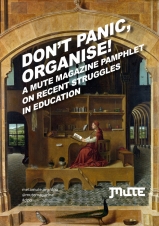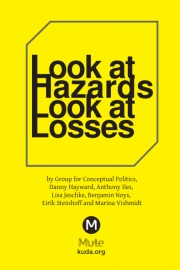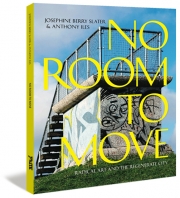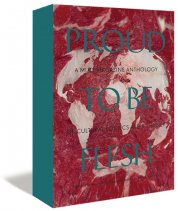Digital Cold Front
Against a background of culture’s wider digitisation, the Transmediale festival is moving beyond its new media art niche – but into what? asks Sam Williams
If political upheaval spurs innovation, the potential of global, environmental catastrophe to unleash cultural change must be awesome. At least, this seems to be the thinking behind the cloud of apocalypse hanging over the 2009 Transmediale International Festival for Art and Digital Culture in Berlin. The starting point of the programme for 2009’s festival, themed ‘Deep North’, is a question: ‘In the wake of climate change are we ready for a cultural rethink?’ The answer seems to be ‘yes’. It continues: ‘Deep North is not a place any of us ever have, or will ever visit’ but an ‘unimaginable scenario’, where it is, ‘always too late’. The programme verges into infuriating contradictions: Elsewhere, Deep North is something ‘we can imagine, perhaps even vaguely define’. The melting ice caps have become the symbol of climate change in the media. As such, they are clearly invoked here. But there is something else too – an End-of-the-World scenario of permanent winter, which has little to do with the science of climate change and more to do with dystopian science fiction, such as Anna Kavan’s Ice, which takes winter apocalypse as the backdrop for social breakdown. With survival paramount, behaviours change and psychologies are twisted into different shapes. Deep North wants to fuse science with science fiction.
So why the haze surrounding Deep North and its desire to inhabit these contradictions? Posed as a thought experiment, Deep North dissolves itself into an affective state of ‘awareness’, a ‘subtle state of being signalling a profound re-examination of cultural and technological development, of political transformation and creative sustainability.’ Deep North is presenting itself as a symptom of something else. But this something else is little more than a set of oppositions: culture v technology; politics v creativity; development v transformation v sustainability. The vague expansiveness here is a little suspicious. If Deep North is a symptom, is Transmediale diseased?

Image: Transmediale Awards exhibition, 2009
Physically based in nine locations across Berlin, spreading from Charlottenburg in the West, to Kreuzberg in the East, the festival itself feeds on the power of technology to bring the world to its hub in the House of World Cultures (HKW) in the centre of Berlin. The Transmediale presence is fed into the virtual realm by a conscientious use of the digital technologies it takes as its subject. The website serves as a portal for interaction with the online projects and the live discussions driving the festival. Meanwhile, on-site events make use of technologically-assisted communication methods – skype, instant messaging, and streaming technologies – to extend the reach of the festival discussion outside the HKW.
Transmediale began life in 1988 as VideoFest, a prelude to the Berlinale, Berlin’s international film-fest circus. The idea of VideoFest was to showcase small DIY video and contemporary artworks excluded from the larger, commercial festival. VideoFest was, as Berlin’s mayor Klaus Wowereit remarked in 2006 of the city itself, ‘poor, but sexy’.
Berlin is certainly poor. Its unemployment rate hovers around 17 percent and the city has debts of approximately €60 billion. When the Berlinale festival comes to town, it’s the unfamiliarly audible slosh of Big Money which makes it remarkable, as much as the programme itself. Berlinale takes place annualy around Potsdamer Platz in former West Berlin. The area multi-functions, perhaps not coincidentally, as financial and cinema district, and houses the city’s larger cultural entities – the Philharmonie, the State Library, and New National Gallery among them
But while Berlinale simply gets bigger and more glamorous, Transmediale has undergone a chameleonic succession of transformations since 1988. In the run up to its 21st anniversary in 2008, a development plan was steadily being shifted into place. In 2005 it received an eight year funding grant from the German Federal Cultural Foundation, which currently stands at €450,000 a year. Andreas Broeckmann had taken over the artistic directorship in 2001, introducing a focus on software art. The move was canny. Newer media technologies were taking the position that video art had once enjoyed at the rawer edge of contemporary art, and the democratic ideals and subversive tendencies that went with it. Broeckmann was further tasked with marketing Transmediale with yearly themes. ‘Do it Yourself!’ was the cry in 2001. A steady inflation of ambition and idealism accrued. Media art was invited to ‘Go Public!’ in 2002, and to ‘Play Global’ in 2003. The trend peaked in 2004 with ‘Fly Utopia!’ The rhetorical strategy of this chain of straplines was to corral a movementist attitude. New media art had something to offer contemporary art. As a laboratory for newer technologies, it had opened up new pathways for artists to connect art with the social, revivifying art’s claims to offer social critiqe. It was the cool, subversive outsider image of new media art which made it appealing. 2005’s ‘Basics’ shed this aspirational baggage. The image of the festival was being stripped away to reposition it as something else. But what?

Image: Esther Polak, NomadicMILK, 2009
2007’s ‘Unfinish!’ offered some half-answers. Pointedly dropping the ‘media art’ tag, Transmediale became the ‘international festival for art and digital culture’. New media art enclaves feared that Transmediale was turning its back on the small, independently created works that had once been its reason for being. Transmediale put its case as follows:
In contemporary art, digital media like video and electronic networks are now so wide-spread that a strict definition of what constitutes ‘media art’ seems no longer possible. We have therefore decided to alter the subtitle of the festival: Transmediale is no longer called ‘international media art festival’, but ‘festival for art and digital culture’. This name is supposed to demonstrate the step away from the niche of ‘media art’, yet still points to the field of tension between culture and digital technologies, which continues to form the main driving force of the festival.
The attempt at redefinition acknowledged media art’s wider problem and that of the festival that had contained and serviced its niche interests. Having gone public and gone global, new media art was subsumed within contemporary art and underwent the professionalisation that inevitably occurs as incipient movements gain currency. At the same time, the democratising power of digital technologies meant that anyone could create it. And they do; many of the DIY videos on YouTube are really impressive. But the festival structure is not equipped to deal with the thoroughgoing democratisation that new media art itself once envisioned. It is elitist; it needs to select and sift works in order to present them. Transmediale moved to expand its own remit from ‘media art’ to encompass ‘art’ in response to these wider developments.
The scope of the present Transmediale is therefore large. Its artistic components alone take in performance, installation, video, and multimedia elements. 2008 saw another limb added to the artistic programme with the introduction of the Villèm Flusser Award for Critical and Theoretical Practice. Last year, architect Stephen Kovats took over from Broeckmann as artistic director, and the festival’s central location moved from temporary accommodation at the University of Fine Arts to the larger HKW. Nestling on the banks of the Spree, the HKW is strategically placed near to Berlin’s Hauptbahnhof (main train station). Taken together with a conference programme of lectures, a salon section targeted at ‘cultural practitioners’, a bold curatorial statement, and fed through the festival’s programmatic use of new communications technology, the effect is bewildering.

Image: Jan-Peter E.R. Sonntag, AMUNDSEN / I-landscape, 2009
One attempt at organisation is structural. Swathes of artfully-reused tarp form a broken canopy over the the HKW atrium, as if to draw together the festival’s disparate elements. The installation, commissioned from Berlin-based architecture collective, raumtaktik, simulates an emergency shelter for the projected Deep North state. On the HKW balcony a ring of small marquees adds an outdoor component. The installation model is the refugee camp. Spread across the floor, ‘digital nomads’ zone out on piles of Seran-wrapped mattresses, with panels of the shelter structure doubling as projection screens for video works. This WIFI-equipped central space is the hub of the festival sprawl. For the small number of festival-goers not toting laptops, it is banked by terminals from which the Transmediale database of media art projects can be accessed.
The main exhibition, Survival and Utopia: Visions of Balance in Transformation, extends the theme set in the foyer, using the same white tarp and blue incident tape as the shelter structure. At the entrance, a sign made from duct tape informs that all materials have been recycled from the refuse of previous exhibitions. But the shelters dividing up the exhibition pieces are neat and uniform in appearance, which seems odd in an exhibition posing as having been assembled hastily from scraps of refuse. In the works themselves, there is a clear preference for carefully constructed and solid physical presences, artisanal in character.
A large ice block, slowly dripping into a tray, is suspended in the centre of the room. Probes are frozen into the body of the ice like insects in amber. AMUNDSEN / I-landscape invites you to stand on a vibrating podium and don headphones through which the data recorded by the probes are channelled into sound. A large screen on the rear wall of the exhibition shows footage shot near the home of the Norwegian polar scientist who lends his name to the work. Like other works here, it uses full sensory experience to wrap the viewer into an experience. The viewer becomes a necessary part of the work, compelled into complicity with it. The aim seems to be to implicate us in the process of climate change it takes as its subject.
Machines also feature prominently here. CLICK & GLUE by Jane Linka floats a large helium balloon in a space enclosed by four metal panels. Glue deposits left by a machine attached to the balloon tack out its path, until it becomes trapped in the web left behind it. Esther Polak’s NomadicMILK uses specially designed robots and GPS technology to reconstruct the routes of milk-product merchants in Nigeria. Leaving trails of sand behind them, the robots follow these routes, mapping them on the floor of the exhibition hall.

Image: Christian Gützer, Grow – Fruits of Kronos, 2007
Large metal structures, balloons, machines inviting their workings to be explored; there is a Renaissance pose being struck here. It is most apparent in Christian Gützer’s Grow Fruits of Kronos, which looks like something you might expect to find in the laboratory of a deranged Florentine scientist. A plant is positioned in a large, articulated metal frame. An algorithm controls the mechanism, moving the plant around a fixed light source. The plant’s growth becomes a document of the algorithm, its biologically-programmed growth responses reprogrammed by the machine.
This tendency isn’t as surprising as it first seems. It was during the Renaissance that the machine was incubated, as the drawings of Leonardo da Vinci show. But the Renaissance is also a convenient shorthand for frenzied innovation, and the fecund cross-pollination between art and science. It resonates with certain narratives of cultural progress with which digital technologies and technologically inspired art have a flirtatious, but uneasy relationship. The machines here are made to perform tracing actions: they make movements that we can follow from point A to point B. There is clearly a nostalgia for the observable workings of the machine, which have disappeared with digital technology into the virtual migrations of 0s and 1s through Boolean mechanisms.
The Tantalum Memorial by Harwood, Wright, and Yokokoji is the winning exhibition piece and brings some of these ideas together. The art limb of a larger project, it commemorates three million dead in the Coltan wars in the Congo. Tantalum is mined for use in various modern communication devices, including mobile phones. The installation is built out of Strowger switches, which operated the first automatic telephone exchanges. The mechanisms are exposed, heavy and tactile, and inserted into a stainless steel frame. The installation looks rather like a bank of giant mechanical grasshoppers, chirruping loudly as the switches click into place. Presented for exhibition, they appear exotic – almost as if they attain, through their obsolescence, to a kind of organicity and queered innocence.
The Strowger switches deploy the power of cultural salvage. Presenting the switches as art draws attention to their absent function. The apparent use to which they are put, dialling into a network of Congolese participants in London, is a fabricated one. The community becomes a social apparatus hooked into, and ‘hacked’ by the work. The communication that is really being performed is with the Transmediale community in West Berlin. The switches perform themselves rather like a bear dancing in a cage. This is not so much the redemption of the mechanical as the reanimation of its carcass: the machine can be exhibited and paraded as exotic and organic because, in a digital environment, it has lost the social functionality that now adheres to the digital. The sympathy with the machine and the lust for nature that dominate the exhibition betray a sort of digital ennui.
The imagined Deep North state seems to be not so much about climate change, as a general sense that we are now in the the digital wilds without a map. The early fallout of digital technology has displaced theories of liberation from information control that accompanied its initial stages. Knowledge retains power, but the power struggles have shifted. It is no longer the access to information, so much as how to assess it that matters. Tactical skills for dealing with informational surplus and detecting structures in its clouds now offer the leverage that mere information once promised.

Image: Graham Harwood, Richard Wright, Matsuko Yokokoj, Tantalum Memorial, 2008
The festival’s daily salon element, ‘Digital Greenhouse’ attempts to work out some of the issues associated with this shift, claiming to present strategies for ‘rehacking your world’. One session looks at the ways in which personal YouTube clips capture, or humorously enact, climactic disaster scenarios. Another questions the usefulness of the introduction by private global actors of advanced communication technologies to ‘underdeveloped’ countries, when it results in governments slackening their hold and the decay in social infrastructure. But these attempts are floored by the communications technology that is supposed to facilitate them. In the Digital Greenhouse, a raft of screens compete for attention. Two show images, while another displays a field report from Nigeria via webcam link-up. Yet another screen scrolls the simultaneous online conversation. A moderator somewhere in the room frantically battles poor connection to relay conversations within the salon to the chatroom online. A camera beams images from the ‘salon’ back into the digital realm. A small laptop passed around the audience causes further disturbance as people try to fathom what they are supposed to do with it. Meanwhile, the main participants try to keep hold of the topic. Inevitably, threads are dropped. The Digital Greenhouse emerges as virtual Babel.
The ‘digital culture’ element of Transmediale’s name-change operates a drift of focus from art and into its environmental concerns, the support system in which it operates. But it’s really not clear what ‘digital culture’ is or could mean. Digital technology has already drilled down into many aspects of our lives and changed them. To take up the language of Transmediale’s 2007 title ‘Unfinish!’, where does ‘digital culture’ finish? How can it be defined against a culture that is not digital? Even the most traditional cultural entities are now tech-savvy. Cultural produce swims through the channels of the internet and digital operations silently form culture in the physical world. All culture is operating within a digital mainframe. This is the problem that the festival itself is running up against, its sickness. Having lost its niche appeal, precisely because all culture is now digitally-infused, Deep North operates a further strategic transition. Climate change is perhaps the most bankable of topics in contemporary cultural discourse. It is not surprising, therefore, that it is the conferences, rather than the art, that take up the front section of Transmediale’s programme, boldly entitled ‘Making/Thinking: the Cultural Tomorrow’. Closing his opening lecture, Claus Leggewie tells the assembled audience: ‘I would like to leave you with no conclusions, but with art’. But in the cultural cocoon phase that we inhabit, it is conclusions that are being chased. In the tough cultural and economic climate of the present, Transmediale is staking its claim to pronounce on the future.
Sam Williams <samanthajaynewilliams AT googlemail.com> is based in Berlin
Info
Transmediale International Festival for Art and Digital Culture 09: Deep North ran from 27 January – 1 February, 2009, http://www.transmediale.de/
Mute Books Orders
For Mute Books distribution contact Anagram Books
contact@anagrambooks.com
For online purchases visit anagrambooks.com






